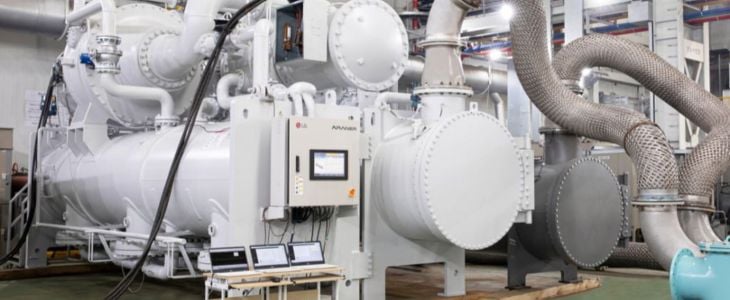Waste heat recovery is the driver of some of the most advanced breakthroughs in thermal engineering today. The basic premise behind waste heat recovery is, in itself, revolutionary: to be able to reuse heat that would otherwise be lost and apply it productively.
Waste heat recovery represents a fundamental shift towards circular models, a movement that is particularly important in the current context. A key data point illustrates the urgency of this paradigm change: heating and cooling is responsible for around 50% of all energy consumed in the EU, with 70% percent of it still originating from fossil fuels (mainly natural gas). In this scenario, waste heat recovery initiatives represent one of the top opportunities for sustainable heating projects that minimize emissions while also promoting a responsible and efficient use of resources.
Today, many routes are being experimented with for applying waste heat recovery to maximize efficiency and sustainability. Within these parameters, heat pumps stand out for their unique advantages, including the capacity to optimize low-grade heat and facilitate its application in district heating. Such is the case of initiatives that are decarbonizing heat by recovering heat from urban wastewater.
Today, we explore the potential of recovering waste heat from flue gases using a combination of heat pumps and turbine condensers. In this approach, flue gas condensation enables the capture and utilization of significant amounts of otherwise wasted heat. The heat pump’s evaporator plays a key role in cooling these gases from the flue gas condenser, allowing the recovered energy to be upgraded and then efficiently transferred via its condenser to a turbine condenser, optimizing overall energy use and enhancing sustainability in industrial processes.
The potential of flue gas for waste heat recovery
To a great extent, the potential of waste heat recovery is yet to be fulfilled. In fact, a look at figures reveals this opportunity: a report published by the U.S. Department of Energy found that somewhere “between 20 to 50% of industrial energy input is lost as waste heat in the form of hot exhaust gases, cooling water, and heat lost from hot equipment surfaces and heated products.”
When looking at flue gas in particular, waste heat recovery models must consider the exact characteristics of these exhaust residues in order to turn them into actual resources. As such, moisture levels, temperature and composition greatly determine their potential as recovered heat, as well as system’s design requirements. In fact, depending on the fuel, flue gas can contain “15-40% of the total energy content in the fuel” (Defu, et al., 2004, as cited in Khadka, 2019).
In this context, flue-gas condensation via heat pumps and turbine condensers has been studied and successfully implemented as a means to access such energy, which would otherwise be lost, enabling top thermal efficiencies. This is particularly true for fuels with high moisture levels (such as biomass or urban waste incineration), which have a greater potential for condensation processes.
Furthermore, this technology presents a particularly interesting opportunity for its capacity to lower flue gas emissions, minimizing this residue’s environmental impact and turning it into a resource.
Heat pumps and turbine condensers: how the waste heat recovery process works
The core principle behind this process is to lower the flue gas temperature, so that the heat energy present in the gas can be recovered. Then, such heat is upgraded, boosting its temperature as needed to make it useful for applications such as district heating.
For example, the system can operate in three main stages, each playing a role in extracting, upgrading, and delivering heat efficiently:
Stage 1: Heat extraction – flue gas condensation
The extremely hot flue gas (represented by a red line) first passes through a quench, which functions like a water shower that cools down the gas (illustrated by blue lines representing cold water).
Next, the gas enters a two-stage scrubber (yellow line). During this process, some of the water vapor present in the gases condenses into hot liquid water (light blue line).
This condensed water contains thermal energy that can be reused.

Stage 2: Heat pump cycle – optimizing heat utilization
In the first stage of the scrubber, the heat from this water is directly transferred to the district heating return water using a heat exchanger. Once heated, this district heating water enters the heat pump condenser, where it is further heated to the required temperature.
In the second stage of the scrubber, another cooling circuit is used. Here, the scrubber water is further cooled down using another heat exchanger connected to the heat pump evaporator. This allows for additional heat recovery.
Stage 3: Heat transfer to the turbine condenser
A key optimization of this system is the potential reuse of the heat pump’s condenser water to assist in condensing the steam from the turbine’s exhaust.
- Heat Recovery Optimization:
- The hot water exiting the heat pump’s condenser can be redirected to the turbine condenser, where it is used to cool and condense the exhaust steam from the turbine.
- Efficient Thermal Exchange:
- If the heat pump’s condenser water is cool enough, it can be used directly in the turbine condenser.
- Alternatively, a heat exchanger can be used to adjust the temperature before reaching the turbine condenser, ensuring optimal condensation efficiency.
- System Benefits:
- Maximized heat recovery, reducing energy waste.
- Lower water consumption, as the turbine condenser can reuse heat pump water.
- Increased plant efficiency by ensuring multi-stage heat utilization before final heat rejection.Why choose heat pumps for waste heat recovery?
Heat upgrade capacities
Heat pumps stand out for their capacity to upgrade low temperature levels, facilitating the reuse of the heat present in flue gas (and, in other models, other waste materials), turning it into useful resources.
The basic working principle of heat pumps is to move heat from one location to another (in this case, from the waste heat source to a higher temperature application). In order to do so, a refrigerant fluid is used to absorb the waste heat, which then goes through a compression and expansion cycle that ensures the heat is released at a higher temperature. Thanks to the most advanced heat pumps today, this process can be executed with top energy efficiency, achieving operational cost savings and minimum emissions.
As mentioned in van de Bor et al. (2015), large volumes of waste heat are released as low-grade, as they are in temperature ranges of between 45-60 °C. Even in this low temperature range, heat pumps are able to deliver exceptional energy value.
Heat pump efficiency
On account of the working principle outlined above, heat pumps also present outstanding efficiencies for designing waste heat recovery systems.
In short and as endorsed by the IEA, heat pumps are an extraordinarily efficient piece of equipment when compared to other heat generation technologies “because most of the heat is transferred rather than generated”.
This leads to remarkable Coefficient of Performance (COP) values. Depending on the type of heat pump, most heat pumps today present COP values between 3 and 5 (meaning the energy output is three to five times higher than the input).
A sustainable, emissions-free option
When powered by renewable energies, heat pumps can operate producing zero or near-zero emissions.
This has prompted widespread support from energy authorities across the globe: the European Commission praises heat pumps as “key to enabling the clean energy transition and achieving the EU’s carbon neutrality goal by 2050”; meanwhile, the IEA estimates that “heat pumps globally have the potential to reduce global carbon dioxide (CO2) emissions by at least 500 tonnes in 2030”, which equal to the annual CO2 emissions of all cars in Europe today.

Financial incentives
This extensive endorsement by officials and institutions at a global level has also translated into a number of financial incentives for installing heat pumps. In fact, the IEA’s ‘Future of Heat Pumps’ report estimated that already in 2022 over 30 countries offered such incentives, covering 70% of heating demand.
The comprehensive benefits of waste heat recovery via the turbine condenser and heat pumps model
- Provides a viable circular model that turns harmful byproducts from flue gas into heat resources.
- Reduces emissions from flue gas related to particulates and certain gases, including emissions related to acid gasses such as sulfur dioxide (SO2) and HCl emissions (Khadka, 2019) which are considered pollutants and have harmful effects on both the environment and human health. Additional arrangements can be made to reduce other emissions related to flue gas (including NOx emissions) during the process.
- Other sustainability benefits arise from the system’s capacity to recover and reuse heat, so that the need for burning additional fuel is reduced, leading to lower emissions of CO₂ and other pollutants for generating heat.
- The incorporation of heat pumps ensures the system’s efficiency, producing a larger output of energy when compared to the energy input necessary to drive the process.
- The system promotes a reduction in the overall operational costs to attain heat. On the one hand, the harnessing of waste heat ensures reduced energy consumption for the same output. On the other hand, the efficiency and COP of heat pumps further contribute to maximize output results.
- Thanks to the upgrading performed by heat pumps, the recovered heat is extremely versatile. As part of district heating, it can be used for space heating or water heating, as well as district energy models for both heating and cooling.
- Reduces the need for industries to devise systems to dispose of excess heat. Instead, a more self-sufficient model is created, while also lowering environmental and regulatory costs associated with heat disposal.
- Promotes energy autonomy, with the system being less reliant on external sources for energy. As such, it reduces vulnerability to fuel price fluctuations or other energy sourcing uncertainties.
Waste heat recovery thus represents a circular, self-sufficient heating system that harnesses the hidden potential of what would otherwise be harmful by-products, turning them into actual resources.
The recovered heat is a versatile energy asset that has proven instrumental in powering advanced district heating initiatives, making significant moves to decarbonize heating.
At ARANER we’re committed to helping our clients design and implement the most advanced thermal energy initiatives. As such, we’re allies in developing state-of-the-art sustainable heating projects where efficiency and sustainability are at the center.
Want to learn more? Discover our district heating line, download our free ebook ‘District Heating’ and get in touch with us to speak to our team about how we can help you.










